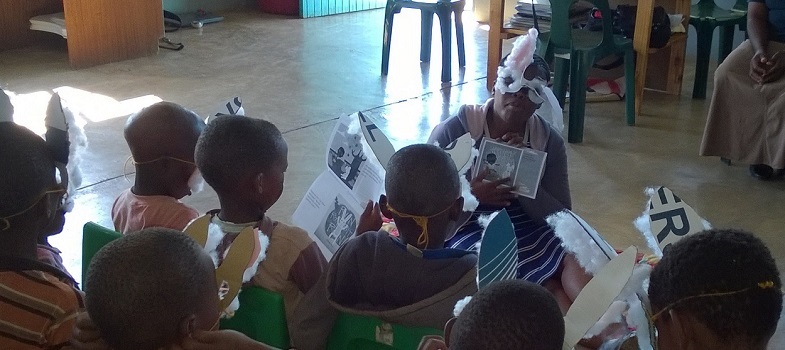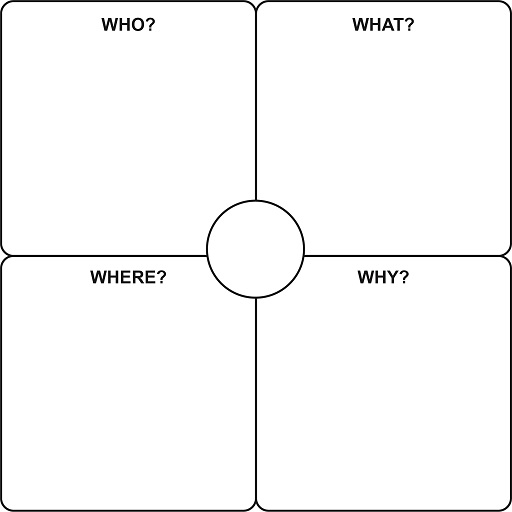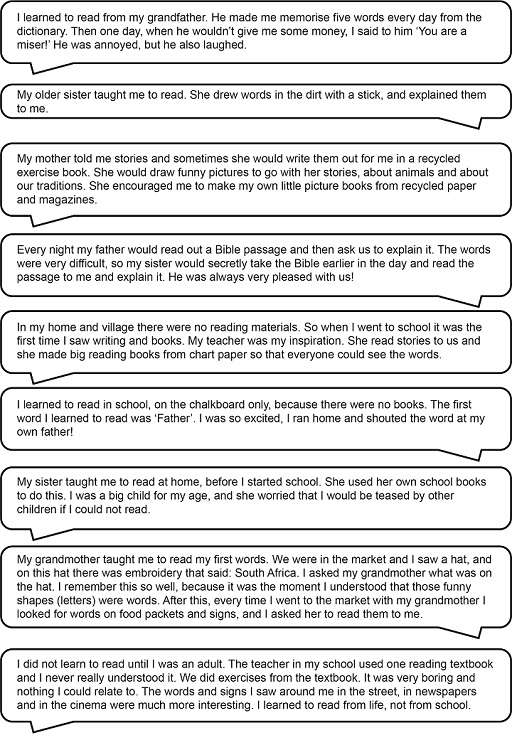How do children learn to read?
You are a skilled and confident reader. You are reading this academic study unit, and it is likely that you read every day for work and for enjoyment in books, newspapers, magazines, and of course online. But how did you learn to do all this?
Activity 1.2: Your memories of learning to read
Think for a moment about your own experiences as an early reader when you were a young child.
- Who helped you learn to read?
- What did you read for the first time?
- Where did you read it? Why did you read it? Did you read it more than once? Have you read it since?
Create a chart in your study notebook like the one in Figure 1.3. Write your name in the middle of the chart. Then write your answers to the following questions:
- Was there someone who helped you learn to read?
- What do you remember reading?
- Where did you lear to read – in school, at home or in another place, or a mixture of these?
- Why was learning to read important? What factors do you think made it possible for you to learn to read? Or were there factors that prevented you from learning to read?
Share your memories with a colleague and discuss what were the similarities and differences between your memories of learning to read.
Comment
As you can see, there are many pathways to reading – there is no single way to learn how to do it. There are also many reasons to read, for pleasure, for information and for a range of different purposes. Often, our most important reading experiences happen at home and with family members, before we start school.
Now look at Figure 1.3 from the perspective of the young children who are in your classroom. Instead of your own name in the middle of the chart, add the name of one of the children in your class. As the teacher of early reading, you are the ‘Who’ in this chart, but there may be other people who will also play a significant part in this child learning to read. The ‘Where’ is your school, but home or church may also be an important place in this child’s ‘reading journey’. The ‘Why’ of reading will be individual to each child. Later in this course you will focus on ‘What’ to read when we look at different resources.
School reading can be very different to reading that is done at home and in the community. As a teacher, it is your job to draw on all the resources available to the child to help them to see the value and enjoyment in learning to read, and not just something that they do at school. In this way you will be contributing to their personal development, and wellbeing.
Activity 1.3: Analysing the experiences of others when learning to read
Read the comments in Figure 1.4 that African teachers have shared with us about learning to read. As you read their memories, think about the following questions you have already reflected on:
- who helped them read?
- what they read?
- where they read?
- why they read?
Choose one of the learning to read accounts that is most similar to your own experience of learning to read and record in your notebook.
Discussion
Who? Did it surprise you to see how many different people were mentioned as being key people in helping these individuals learn to read? One person remembered an inspirational teacher. Others talked about members of their family who had taught and encouraged them. Sometimes this was their mother or father, but also older siblings or a grandparent. People of different ages can help children learn to read. As teachers we are a vital part of this process.
What? Learning to read can draw on a range of resources. This includes books but is not limited to only school textbooks – listening to stories, learning words from memory and reading words in the market are just some of the ways mentioned in these accounts that can help children to read.
Where? Learning to read can take place in a classroom but also at home, in the street or village. A library may be a special place that encourages a love of reading. Children may begin to read in one place, but they will learn more easily if they are encouraged to read at home and in school and in their community.
Why? Children can start to learn to read out of curiosity, for example seeing an older sibling reading. There are also examples in these accounts of older brothers or sisters wanting their younger siblings to do well at school. In some of the accounts, reading is an important part of family life.
It is important as teachers to think about reading not just as a skill for children to learn but as a process that involves people and things around us. It is a unique part of our own history: how we learned to read helps to make us who we are.
Foundational literacy





